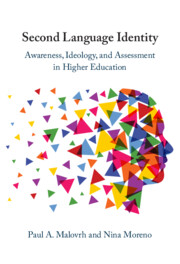Book contents
- Second Language Identity
- Second Language Identity
- Copyright page
- Dedication
- Contents
- Figures
- Tables
- Preface
- Acknowledgments
- 1 On Actors, Architecture, and L2 Advancedness in Higher Education
- Part I Advancedness and the L2 Learner
- Part II Variable Notions of Advancedness
- 5 Language Departments’ Architecture, Ideology, and Mission Regarding L2 Advancedness
- 6 A Quantitative Analysis of Variability in Perceptions of L2 Advancedness among Practitioners, Researchers, and Administrators in Higher Education
- 7 A Qualitative Analysis of Language Professionals’ Descriptions of Their Ideology and Assessment of Advanced L2 Spanish
- Part III Assessment, Identity, and Critical Language Awareness As Markers of Advancedness
- Book part
- Bibliography
- Name Index
- Subject Index
5 - Language Departments’ Architecture, Ideology, and Mission Regarding L2 Advancedness
from Part II - Variable Notions of Advancedness
Published online by Cambridge University Press: 27 July 2023
- Second Language Identity
- Second Language Identity
- Copyright page
- Dedication
- Contents
- Figures
- Tables
- Preface
- Acknowledgments
- 1 On Actors, Architecture, and L2 Advancedness in Higher Education
- Part I Advancedness and the L2 Learner
- Part II Variable Notions of Advancedness
- 5 Language Departments’ Architecture, Ideology, and Mission Regarding L2 Advancedness
- 6 A Quantitative Analysis of Variability in Perceptions of L2 Advancedness among Practitioners, Researchers, and Administrators in Higher Education
- 7 A Qualitative Analysis of Language Professionals’ Descriptions of Their Ideology and Assessment of Advanced L2 Spanish
- Part III Assessment, Identity, and Critical Language Awareness As Markers of Advancedness
- Book part
- Bibliography
- Name Index
- Subject Index
Summary
Since the MLA’s 2007 call to restructure the traditional two-tier L2 programmatic structure, the field has identified various challenges. Difficulties arise when, as Maxim (2009) posited, there is a disconnect between the reality of L2 programs, how program administrators engage with that reality, and the disciplinary mission. In terms of reality, research shows that L2 leaners prefer courses that focus on skill development and hope to gain sociocultural proficiency by studying abroad, that successful learners are comfortable interacting with the L2 via multimedia and online tools outside of class, and that enrollment is decreasing as programs appear disconnected from societal and labor market demands for “advanced” speakers. Some have responded by developing curricula in which upper-tier skills such as sociocultural proficiency are introduced earlier. The most promising approaches are those that adapt to evolving societal expectations to produce learners who are aware and critically reflective of the relationships between context and language use. We posit one solution as the reconceptualizaton of a unified program mission to bridge the language/content divide.
Keywords
- Type
- Chapter
- Information
- Second Language IdentityAwareness, Ideology, and Assessment in Higher Education, pp. 93 - 109Publisher: Cambridge University PressPrint publication year: 2023

